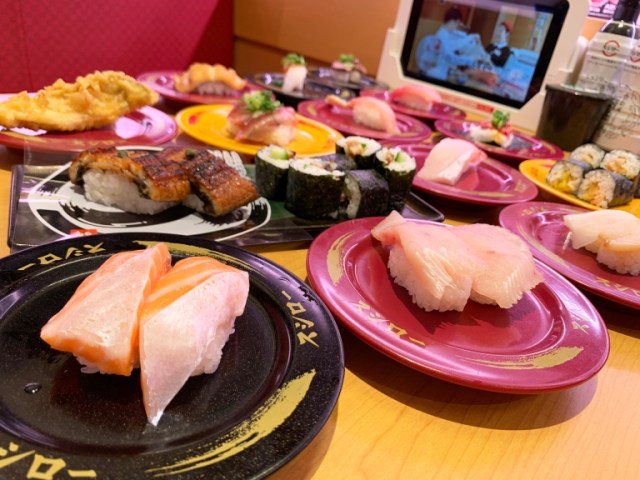
We go kaitenzushi hopping for a back-to-back-to-back-to-back maguro comparison.
Easy access to tasty sushi is, undeniably, one of the greatest things about being in Japan. But being spoiled for choice means that whenever we find ourselves craving sushi, we then have to answer the question of which sushi restaurant we’re going to eat at.
Even within the subset of kaitenzushi, or conveyor belt sushi, restaurants, we’ve still got multiple options to choose from, and our Japanese-language reporter P.K. Sanjun has made it his mission to find out who’s the best of the best among Japan’s big four kaitenzushi chains of Kappa Sushi, Kura Sushi, Sushiro, and Hama Sushi.
▼ Clockwise from top left: Kappa Sushi, Kura Sushi, Sushiro, and Hama Sushi
P.K.’s massive stomach capacity is well documented, but even for him eating the entire sushi lineup at all four restaurants is too large a task/meal plan. So instead, he’s starting his investigation by ordering and eating maguro, or tuna, sushi at each. Mauro is one of the most popular kinds of sushi, so foodies often use it as a baseline test for the overall quality of a sushi restaurant. A good sushi restaurant should have good maguro, and one that stumbles over such a fundamental sushi essential probably isn’t going to surprise you with the quality of their more esoteric ingredients.
▼ Once again, clockwise from top left: Kappa Sushi, Kura Sushi, Sushiro, and Hama Sushi
To get the most accurate comparison possible, P.K. visited all four restaurant back-to-back-to-back-to-back on the same day, and here are his taste-testing notes.
● Kappa Sushi (110 yen [$US0.95])
First up is Kappa Sushi, which, like three of the four restaurants on our list, prices its maguro at 110 yen for two pieces. The cuts of fish were nice and thick, and remarkably low in tendons, giving them a smooth, uniform texture. There was a little more moisture in the fish than P.K. would like, but overall, this was some solid maguro that didn’t disappoint.
● Kura Sushi (110 yen)
Kura Sushi also uses thick-cut tuna, and the fish was refreshingly moist without feeling soggy, with a nicely balanced texture that’s neither too soft nor too firm. It felt a little lacking in umami, by P.K.’s standards, but all in all, not bad, especially for the price.
● Hama Sushi (110 yen)
Hama Sushi’s tuna was similar to Kura’s, with a bit more sinuous texture and a little more umami, though a bit more still would have raised it to another level of deliciousness. Still, this was P.K.’s favorite so far.
● Sushiro (132 yen)
But if we’re talking about the maguro that really was on a higher level, that’s Sushiro’s. For P.K., this was the best of the four by far, thanks to it being the most umami-rich and flavorful.
That’s not to say that any of the contenders were bad, though, and P.K. could see himself happily eating multiple plates of any of the restaurants’ maguro. But since he usually doesn’t go to four restaurants in a single day and has to pick just one, if he’s craving maguro, Sushiro is his first choice. Really, the only drawback is that Sushiro’s tuna is the most expensive of the bunch. An extra 22 yen is a pretty affordable luxury, though, and outside of the big cities some Sushiro branches offer their maguro for just 110 yen, so fitting it into your budget isn’t that hard to do.
Photos © SoraNews24
● Want to hear about SoraNews24’s latest articles as soon as they’re published? Follow us on Facebook and Twitter!
[ Read in Japanese ]

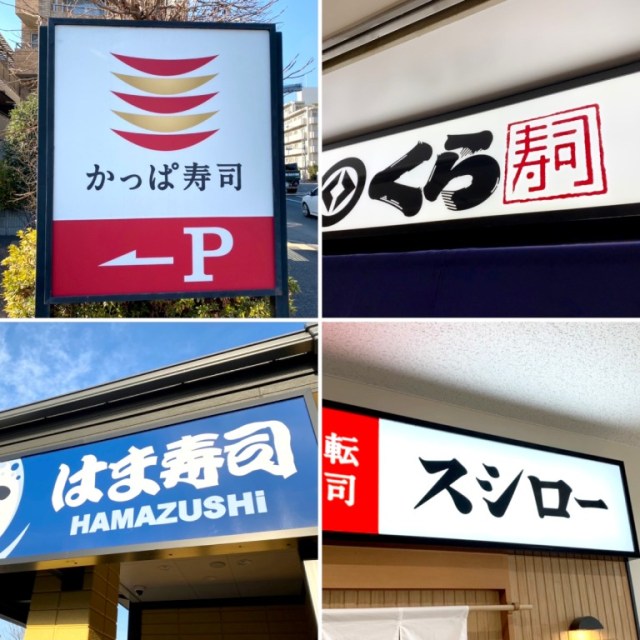
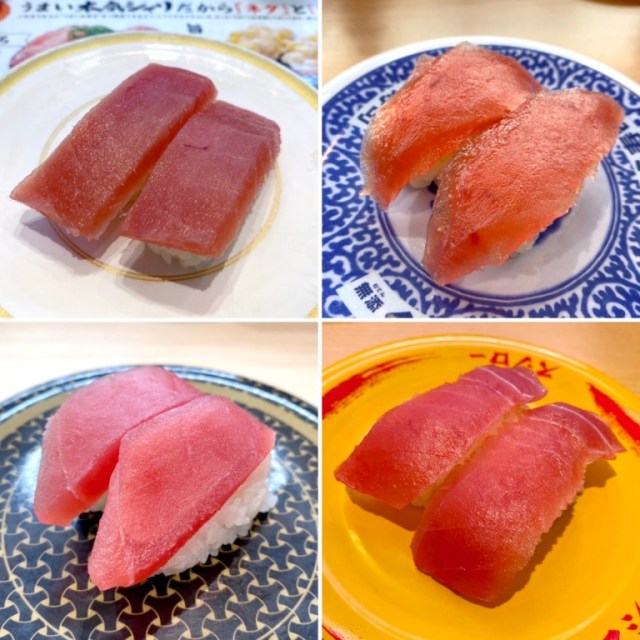
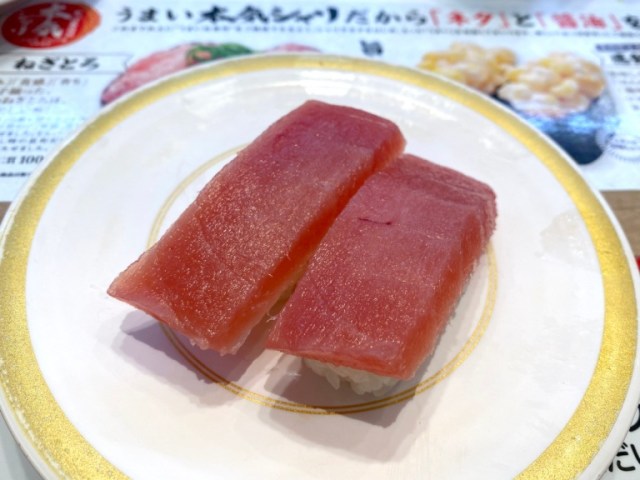

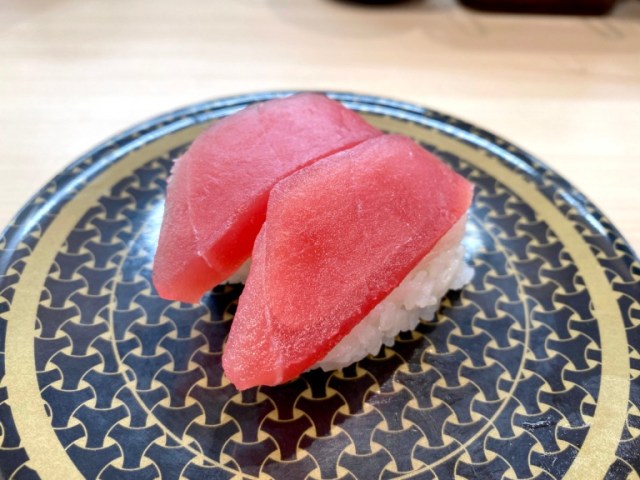
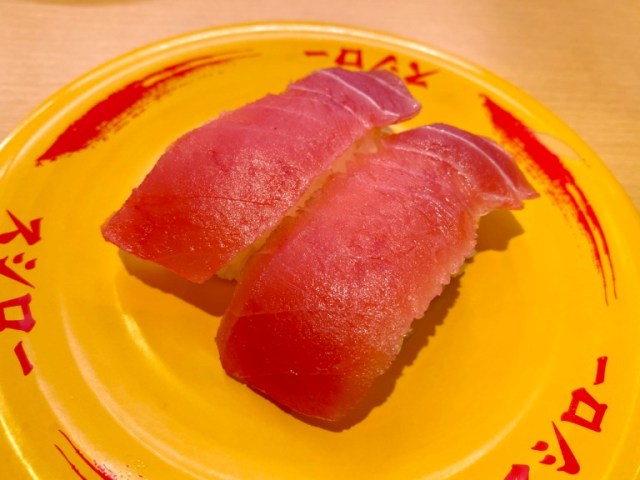
 Which Japanese conveyor belt sushi chain has the best salmon sushi?【Taste test】
Which Japanese conveyor belt sushi chain has the best salmon sushi?【Taste test】 Which Japanese conveyor belt sushi chain has the best saltwater eel sushi?【Taste test】
Which Japanese conveyor belt sushi chain has the best saltwater eel sushi?【Taste test】 Which Japanese conveyor belt sushi chain has the best bintoro sushi?【Taste test】
Which Japanese conveyor belt sushi chain has the best bintoro sushi?【Taste test】 Which Japanese conveyor belt sushi chain has the best negitoro sushi?【Taste test】
Which Japanese conveyor belt sushi chain has the best negitoro sushi?【Taste test】 Which Japanese conveyor belt sushi chain has the best salad sushi?【Taste test】
Which Japanese conveyor belt sushi chain has the best salad sushi?【Taste test】 Japan’s new difficult-to-drink-from beer glass protects your liver, but it’s a brutal experience
Japan’s new difficult-to-drink-from beer glass protects your liver, but it’s a brutal experience Demon Slayer: Kimetsu no Yaiba gets new roller coaster attractions and food at Universal Studios Japan
Demon Slayer: Kimetsu no Yaiba gets new roller coaster attractions and food at Universal Studios Japan New Pokémon ice cream, dessert drinks, and cool merch coming to Baskin-Robbins Japan【Pics】
New Pokémon ice cream, dessert drinks, and cool merch coming to Baskin-Robbins Japan【Pics】 Hello, cosmetics! Clinique teams up with Hello Kitty this summer for first-time collaboration
Hello, cosmetics! Clinique teams up with Hello Kitty this summer for first-time collaboration New Nintendo Lego kit is a beautiful piece of moving pixel art of Mario and Yoshi【Photos】
New Nintendo Lego kit is a beautiful piece of moving pixel art of Mario and Yoshi【Photos】 Caffeinated ramen for gamers that you can eat with one hand going on sale in Japan
Caffeinated ramen for gamers that you can eat with one hand going on sale in Japan How to order snacks on a Shinkansen bullet train in Japan
How to order snacks on a Shinkansen bullet train in Japan New samurai glasses are Japan’s latest weird must-have souvenir
New samurai glasses are Japan’s latest weird must-have souvenir High-fashion Totoro cuddle purse is like an elegant stroll in the forest【Photos】
High-fashion Totoro cuddle purse is like an elegant stroll in the forest【Photos】 Swords of famous samurai reborn as beautiful kitchen knives from Japan’s number-one katana town
Swords of famous samurai reborn as beautiful kitchen knives from Japan’s number-one katana town Nintendo history you can feel – Super NES, N64, and GameCube controllers become capsule toys
Nintendo history you can feel – Super NES, N64, and GameCube controllers become capsule toys “The most Delicious Cup Noodle in history” – Japan’s French Cup Noodle wins our heart【Taste test】
“The most Delicious Cup Noodle in history” – Japan’s French Cup Noodle wins our heart【Taste test】 Starbucks releases a cute Frappuccino and Unicorn Cake…but not in Japan
Starbucks releases a cute Frappuccino and Unicorn Cake…but not in Japan Kyoto Tower mascot termination reveals dark side behind cute Japanese characters
Kyoto Tower mascot termination reveals dark side behind cute Japanese characters McDonald’s Japan’s Soft Twist Tower: A phantom ice cream only sold at select branches
McDonald’s Japan’s Soft Twist Tower: A phantom ice cream only sold at select branches Yabai Ramen: What makes this Japanese ramen so dangerous?
Yabai Ramen: What makes this Japanese ramen so dangerous? Finally! Nintendo Japan expands Switch 8-bit controller sales to everybody, Online member or not
Finally! Nintendo Japan expands Switch 8-bit controller sales to everybody, Online member or not Japanese government wants to build luxury resorts in all national parks for foreign tourists
Japanese government wants to build luxury resorts in all national parks for foreign tourists To combat declining birth rate, Japan to begin offering “Breeding Visas” to foreigners
To combat declining birth rate, Japan to begin offering “Breeding Visas” to foreigners 10 things you should buy at 7-Eleven in Japan
10 things you should buy at 7-Eleven in Japan Studio Ghibli releases anime heroine cosplay dresses that are super comfy to wear
Studio Ghibli releases anime heroine cosplay dresses that are super comfy to wear Woman charged for driving suitcase without a license in Osaka
Woman charged for driving suitcase without a license in Osaka Studio Ghibli unveils My Neighbour Totoro miniature house model
Studio Ghibli unveils My Neighbour Totoro miniature house model Kyoto experiencing problems with foreign tourists not paying for bus fares, but not on purpose
Kyoto experiencing problems with foreign tourists not paying for bus fares, but not on purpose Fighting mild hunger with a Japanese soda that turns into jelly in the stomach【Taste test】
Fighting mild hunger with a Japanese soda that turns into jelly in the stomach【Taste test】 Studio Ghibli’s Howl’s Moving Castle tapestry unveiled in Japan for first time
Studio Ghibli’s Howl’s Moving Castle tapestry unveiled in Japan for first time McDonald’s new Happy Meals offer up cute and practical Sanrio lifestyle goods
McDonald’s new Happy Meals offer up cute and practical Sanrio lifestyle goods Sales of Japan’s most convenient train ticket/shopping payment cards suspended indefinitely
Sales of Japan’s most convenient train ticket/shopping payment cards suspended indefinitely Sold-out Studio Ghibli desktop humidifiers are back so Totoro can help you through the dry season
Sold-out Studio Ghibli desktop humidifiers are back so Totoro can help you through the dry season Japanese government to make first change to romanization spelling rules since the 1950s
Japanese government to make first change to romanization spelling rules since the 1950s Foreigner’s request for help in Tokyo makes us sad for the state of society
Foreigner’s request for help in Tokyo makes us sad for the state of society Ghibli founders Toshio Suzuki and Hayao Miyazaki contribute to Japanese whisky Totoro label design
Ghibli founders Toshio Suzuki and Hayao Miyazaki contribute to Japanese whisky Totoro label design Doraemon found buried at sea as scene from 1993 anime becomes real life【Photos】
Doraemon found buried at sea as scene from 1993 anime becomes real life【Photos】 Tokyo’s most famous Starbucks is closed
Tokyo’s most famous Starbucks is closed Princesses, fruits, and blacksmiths: Study reveals the 30 most unusual family names in Japan
Princesses, fruits, and blacksmiths: Study reveals the 30 most unusual family names in Japan Which Japanese conveyor belt sushi chain has the best yellowtail sushi?【Taste test】
Which Japanese conveyor belt sushi chain has the best yellowtail sushi?【Taste test】 Which Japanese conveyor belt sushi chain has the best prawn sushi?【Taste test】
Which Japanese conveyor belt sushi chain has the best prawn sushi?【Taste test】 Which Japanese conveyor belt sushi chain has the best mackerel sushi?【Taste test】
Which Japanese conveyor belt sushi chain has the best mackerel sushi?【Taste test】 Which Japanese conveyor belt sushi chain has the best aburi salmon sushi?【Taste test】
Which Japanese conveyor belt sushi chain has the best aburi salmon sushi?【Taste test】 Which Japanese conveyor belt sushi chain has the best scallop sushi?【Taste test】
Which Japanese conveyor belt sushi chain has the best scallop sushi?【Taste test】 Which Japanese conveyor belt sushi chain has the best squid sushi?【Taste test】
Which Japanese conveyor belt sushi chain has the best squid sushi?【Taste test】 Which Japanese conveyor belt sushi chain has the best hamburger steak sushi?【Taste test】
Which Japanese conveyor belt sushi chain has the best hamburger steak sushi?【Taste test】 Which Japanese conveyor belt sushi chain has the best iwashi sardine sushi?【Taste test】
Which Japanese conveyor belt sushi chain has the best iwashi sardine sushi?【Taste test】 Which Japanese conveyor belt sushi chain has the best egg sushi?【Taste test】
Which Japanese conveyor belt sushi chain has the best egg sushi?【Taste test】 Which Japanese conveyor belt sushi chain has the best Prawn Tempura Sushi?【Taste test】
Which Japanese conveyor belt sushi chain has the best Prawn Tempura Sushi?【Taste test】 Which Japanese conveyor belt sushi chain has the best aosa miso soup?【Taste test】
Which Japanese conveyor belt sushi chain has the best aosa miso soup?【Taste test】 Which Japanese conveyer belt sushi chain has the tastiest sea snail, if any?【Taste test】
Which Japanese conveyer belt sushi chain has the tastiest sea snail, if any?【Taste test】 Which Japanese conveyer belt sushi chain has the best steamed egg custard? 【Taste test】
Which Japanese conveyer belt sushi chain has the best steamed egg custard? 【Taste test】 Which conveyor belt sushi place’s chawanmushi egg custard is the best? We investigate【Taste Test】
Which conveyor belt sushi place’s chawanmushi egg custard is the best? We investigate【Taste Test】 World’s largest Kura Sushi revolving sushi restaurant opens, but not in Japan【Video】
World’s largest Kura Sushi revolving sushi restaurant opens, but not in Japan【Video】
Leave a Reply